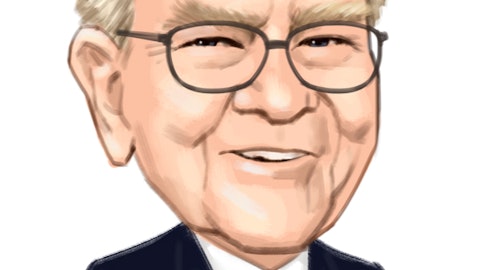American Express Company (NYSE:AXP) Q3 2023 Earnings Call Transcript October 20, 2023
American Express Company beats earnings expectations. Reported EPS is $3.3, expectations were $2.96.
Operator: Ladies and gentlemen, thank you for standing by. Welcome to the American Express Q3 2023 Earnings Call. At this time, all participants are in a listen-only mode. Later, we will conduct a question-and-answer session. [Operator Instructions] As a reminder, today’s call is being recorded. I would now like to turn the conference over to our host, Head of Investor Relations, Ms. Kerri Bernstein. Thank you. Please go ahead.
Kerri Bernstein: Thank you, Donna, and thank you all for joining today’s call. As a reminder, before we begin, today’s discussion contains forward-looking statements about the company’s future business and financial performance. These are based on management’s current expectations and are subject to risks and uncertainties. Factors that could cause actual results to differ materially from these statements are included in today’s presentation slides and in our reports on file with the SEC. The discussion today also contains non-GAAP financial measures. The comparable GAAP financial measures are included in this quarter’s earnings materials as well as the earnings materials for the prior periods we discussed. All of these are posted on our website at ir.americanexpress.com.

A small business owner in front of a terminal, making a deposit to her company’s bank account via the company’s services. Editorial photo for a financial news article. 8k. –ar 16:9
We’ll begin today with Steve Squeri, Chairman and CEO, who will start with some remarks about the company’s progress and results. And then Christophe Le Caillec, Chief Financial Officer, will provide a more detailed review of our financial performance. After that, we’ll move to a Q&A session on the results with both Steve and Christophe. With that, let me turn it over to Steve.
Steve Squeri: Thank you, Kerri. Good morning, and thanks for joining us today for our third quarter earnings call. Q3 was our seventh consecutive quarter of strong performance, continuing in the momentum we’ve built over the last few years and aligned with the growth plan we announced in 2022. It was the sixth consecutive quarter of record revenues which reached $15.4 billion, up 13% year-over-year. Earnings per share of $3.30 was also a new quarterly record. Based on our performance to date, we remain confident in our ability to achieve full year revenue growth and EPS growth that is consistent with the annual guidance we provided at the beginning of the year. And we are well positioned as we seek to achieve our growth plan aspirations of annual revenue growth in excess of 10% and mid-teens EPS growth in 2024 and beyond in a steady state macro environment.
My confidence is based on several factors, including the many attractive opportunities available to us because of the businesses and geographies we operate in, our unique membership model, which powers a virtuous cycle of growth, the success of the strategic investments we’ve been making in key areas of our business, and our ability to leverage our differentiated business model, which includes our premium global customer base, integrated payments platform, strong partner relationships, and trusted brand. Together, these factors have driven our strong performance over the past two years, including the continued momentum we saw in the third quarter. In the quarter, card member spending remained strong, up 7% year-over-year on an FX adjusted basis.
Spending was strongest in our US consumer segment, up 9%, and International Card Services segment up 15% on an FX adjusted basis. And US small business spending increased slightly from a year ago. Millennials and Gen Z consumers continue to be the fastest growing portion of our card member base, with spending from this demographic in the US up 18% year-over-year, and they accounted for more than 60% of all new consumer account acquisitions globally in the quarter. Demand for our products remain robust, particularly for fee-based products, which represented more than 70% of the new accounts acquired in the quarter. Customers continue to be highly satisfied with our products and services, which drives high levels of engagement and retention. We were rated the number one US credit card company for customer satisfaction by J.D. Power for the fourth consecutive year and the 13th time in 17 years of the study.
And our credit metrics remain best-in-class as we continue our focus on growing with discipline and a strong focus on risk management across the portfolio. A key reason for the momentum we’re seeing is the investments we’ve been making in innovating our value propositions to deliver generational relevance across all age groups. Resy is a good example of some of the ways we’re doing this. We acquired Resy and continue to invest in building out the platform because we know that dining is something that all generations of Card Members care about. We’ve seen that in our results as restaurants continued to be the largest and one of the fastest growing T&E categories in the third quarter. The number of Resy users, restaurants on the platform, and reservations booked all continue to grow significantly.
In Q3, reservations on the platform set another quarterly record. Over the last few years, we’ve also ramped up the number of exclusive lifestyle experiences, sponsorships, and access to events we offer that appeal to our Card Members across generations and geographies and reinforce the unique value of membership. Our highly popular experiences cut across entertainment, sports, food, art, and fashion. They generate strong on-site engagement with our branded activities and offers, and they help drive interest among prospects. They also continue to attract world-class partners who work with us to add new ways for our Card Members and prospects to experience the power of Amex membership. Earlier this week, we announced our latest sponsorship, an exclusive multi-year agreement with Formula 1 to be the official payments partner of Formula 1 in the Americas.
This sponsorship is our first new sports vertical in over 10 years, and it represents a great opportunity to build on the rapidly growing popularity of Formula 1 racing around the world. Another way we’re delivering generational relevance is by regularly refreshing and adding value to our products on a global basis. These product enhancements are tailored to the interest and spending patterns of our customers of all age groups in each local market. So far this year, we’ve made enhancements to over 20 premium products across the company, some of the latest of which were refreshes of our Platinum Card products in Japan, our Business Gold Card in the US, and just yesterday, our Hilton co-branded consumer cards. These examples and many others like them are further enriching our membership model, which helps us attract new premium customers, drive retention and deepen engagement with current customers and add more merchants and partners who provide offers and experiences that deliver additional value.
Looking ahead, I feel very good about where we are and where we’re going. We’ll continue our strategy of investing for growth and adding more differentiated value to our membership model to deliver generational relevance, while continuing to leverage the strengths of our business model, all of which gives us a competitive advantage. I’ll now hand the call over to Christophe Le Caillec for additional detail on our quarterly results.
Christophe Le Caillec: Thank you, Steve, and good morning, everyone. I’m excited to have my first earnings call be one where we discuss our continued strong momentum which is reflected in our record revenue and EPS in the third quarter. I would like to take a minute at the outset to share my perspective on the company as someone who has been here for a long time and through various business environments. The company is very focused on driving high levels of profitable revenue growth. The key enabler of that growth has been the discipline we use to deploy our resources. As a result, the underlying quality of our business is very strong, and I have confidence in the sustainability of the growth drivers that we are seeing. We have accelerated the pace of our revenue and EPS growth since before the pandemic.
That acceleration is a direct result of the strategy that underpins our growth plan, which Steve described. In the quarter, that strategy has driven $27 billion more in billings versus last quarter. The company is also generating almost $2 billion more in revenue and about $600 million more in net income compared to a year ago. This demonstrates the earnings power of our business model. Now let’s take a look at the details of this quarter’s performance. Starting with our summary financials on Slide 2. Third quarter revenues were $15.4 billion. They reach a record high for the sixth straight quarter and were up 13% year-over-year. This revenue momentum drove reported net income of $2.5 billion and earnings per share of $3.30, which grew 34% year-over-year.
Let’s now go to a more detailed look at the drivers of these results. In our spend-centric business model, that begins with a look at bill business starting on Slide 3. Total billed business grew $27 billion this quarter versus last year, up 7% on an FX adjusted basis as we continue to see the more stable growth rates that we expected. This growth was driven by 6% growth in goods and services spending, consistent with last quarter’s growth rate and sustained double digit growth in travel and entertainment spending. This double-digit T&E growth has been driven by continued demand for travel and dining experiences with the restaurant spending, our largest category, up 13% this quarter. Total network volumes grew 6% year-over-year on an FX-adjusted basis.
As you look at these results, I’d note that we exited a small product last quarter that was reported in our process volumes. This is reflected in the Q3 growth rate and expect to see the impact of the year-over-year growth rate continue for the next few quarters until we lap this exit. As a reminder, process volume includes volumes from cards where we play more of a network role and from alternative payment solutions that we facilitate. The revenue associated with these volumes makes up a small portion of our total revenue, which you can see on Slide 11. As we then break down our spending trends across our businesses, there are a few other key points to take away. Starting with our larger segment on Slide 4. US consumer grew billings strongly at 9% this quarter.
Our focus on attracting, engaging, and retaining our premium Card Members is driving growth across all generations and age cohorts. Millennial and Gen Z customers continue to drive our highest billed business growth within this segment with their spending up 18% this quarter. Looking at commercial services on Slide 5, US SME growth came in at 2% this quarter, consistent with last quarter’s growth rate. As Steve discussed on our Q2 call, organic growth in this segment has slowed given unique dynamics seen by small businesses over the past few years. Importantly, we do continue to see strong high-quality demand for new accounts within this segment. Looking forward, we focus on continuing to help SME clients run their businesses. Billings from our US large and global corporate customers were flat year-over-year.
As we have said for many years, these customers are not a major growth driver for our business, but they remain an important foundation for the company’s business model. And lastly, on Slide 6. You see our highest growth again this quarter in international card services. We saw strong growth across our geographies and customer types. Spending from international consumers and from international SME and large corporate customers, each grew 15%. Overall, strength in spending growth from our US consumers and Card Members outside of the US continues to see — offset the softness with commercial services that we’ve been talking about for the past few quarters. Taking everything into account, our spending volumes are tracking to support our revenue guidance for the full year and our long-term aspirations for sustainable growth rates greater than what we were generating pre-pandemic.
Now, moving on to loans and Card Member receivables on Slide 7. We saw year-over-year growth of 15% as well as good continued sequential growth. As our customers continue to rebuild balances, the interest-bearing portion of our loans and receivables balances continues to grow faster than the overall growth you see. Importantly, over 70% of our revolving loan growth in the US continues to come from our tenured customers. As you then turn to credit and provision on Slide 8 through 10, the high credit quality of our customer base continues to show in our best-in-class credit performance. As you can see on Slide 8, our Card Member loans and receivables, write-offs and delinquency rates both remain fairly flat to last quarter and below pre-pandemic levels.
Going forward, as we’ve talked about for many quarters now, we continue to expect this delinquency and write-off rates to increase over time and they are likely to remain below pre-pandemic levels in the fourth quarter. Turning now to the accounting of this credit performance on Slide 9. The quarter-over-quarter growth in our loan balances, combined with a modest increase in our Card Member loans and receivables delinquency rate resulted in a $321 million reserve bill. This reserve bill, combined with net write-offs, drove $1.2 billion of provision expense in the third quarter. As you see on Slide 10, we ended the third quarter with $5 billion of reserves, representing 2.7% of our total loans and Card Member receivables. This reserve rate remained about 20 basis points below the level we had pre-pandemic or day one CECL.
We continue to expect this reserve rate to increase a bit in the balance of year, similar to the modest increases we’ve seen over the past few quarters. Moving next to revenue on Slide 11. Total revenues were up $1.8 billion or 13% year-over-year in the third quarter. Our largest revenue line, discount revenue, grew 7% year-over-year in Q3, as you can see on Slide 12, driven by spending trends we discussed earlier. Net card fee revenues were up 19% year-over-year on an FX adjusted basis, as you can see on Slide 13. This growth remains very strong and is powered by the continued attractiveness to both new and existing customers of our fee-paying products due to the investment we’ve made in our premium value propositions. As we expected, growth moderated a bit this quarter from the high levels we saw earlier this year, reflecting our cycle of product refreshes.
This quarter, we acquired 2.9 million new cards. Importantly, the acquisition levels you see on Slide 13 remain consistent with our long-term growth aspirations. The spend, revenue, and credit profiles of our new Card Members continue to look strong relative to what we saw pre-pandemic. Moving on to Slide 14. You can see that net interest income was up 33% year-over-year on an FX adjusted basis, driven mostly by the growth in our revolving loan balances. To sum up revenues on Slide 15, we’re seeing broad based revenue momentum across our diversified revenue lines. For 2023, we expect revenue growth to be within the range we communicated in January at around 15% growth for the full year. Moving to expenses on Slide 16, variable customer engagement expenses came in at 40% of total revenues in the third quarter.
Therefore, I now expect these costs to run at around 42% of total revenues in the full year — on the full year basis. Looking forward, we view this cost as a key driver of our momentum as we continue to innovate our value propositions to deepen engagement with our premium Card Members and to attract new ones as Steve discussed earlier. On the marketing line, we invested $1.2 billion in the quarter. I still expect to have marketing spend of around $5.5 billion for the full year, fairly flat to our 2022 expense. We feel really good about the quality of our new card acquisitions, which I talked about earlier, and I continue to see great demand for our products across a wide range of attractive investment opportunities. Given this strong set of opportunities, I would expect to increase our marketing spend in the balance of this year and we’re confident that our sophisticated acquisition engine will continue to do so in an efficient way.
Moving to the bottom of Slide 16 brings us to operating expenses which were $3.7 billion in the third quarter as we invest in critical areas such as our talented colleague base and technology. Taking this into account, we now expect our full year operating expenses to be around $14.5 billion. Looking forward, we continue to view marketing and OpEx as a key source of leverage. Turning next to capital on Slide 17. We returned $1.7 billion of capital to our shareholders in the third quarter. This included common stock repurchase of $1.3 billion and $438 million in common stock dividends, all on the back of strong earnings generation. As you can see on Slide 17, we target a CET1 ratio between 10% to 11%. We ended the quarter with a CET1 ratio of 10.7%, which is well above our current regulatory minimum of 7%.
As we think about the Basel III proposal, the RWA increase could consume the buffer above regulatory capital requirements if the proposal is adopted as written. Notably, we believe there are clear opportunities for improvements between the proposal and the final rule. In fact, the regulators themselves have posed questions about potential issues in applying these rules broadly and we are actively engaged in that dialogue. We plan to continue to return to shareholders the excess capital we generate while supporting our balance state growth. We do not expect any material near-term changes to our capital management approach. That brings me to our growth plan and 2023 guidance on Slide 18. As Steve and I discussed in our third quarter results — our third quarter results, sorry, reflect a continuation of the strong momentum we’ve built over the last few years, evidenced by our performance across diversified revenue streams.
For the full year, we expect revenue growth of around 15%, consistent with the revenue guidance range we provided at the beginning of the year. As I discussed before, we now expect variable Card Member engagement expenses to be around 42% of total revenues on a full year basis, modestly below our original expectation. On marketing, we still expect to spend around $5.5 billion for the full year. And lastly, we now expect our operating expenses to be around $14.5 billion this year, modestly above our original expectation as we invest in areas critical to our success. Taking everything together, our earnings per share guidance remains between $11.00 and $11.40. Looking forward, we remain committed to focusing on achieving our aspirations of sustainably delivering revenue growth in excess of 10% and meeting EPS growth in a steady-state macro environment.
With that, we’ll open up the call for your questions in a moment. A final point which relates to our investor relations teams here at American Express. Steve and I have decided to move Kerri Bernstein to the critical role of Corporate Treasurer. I’d like to thank Kerri for leading the IR function during a period of strong performance for the company. I’d then like to welcome Kartik Ramachandran, our new Head of Investor Relations. Kartik was most recently a key finance lead in our US consumer business and has had a number of finance positions over his 11 years with the company. Now, let me turn it back over to Kerri to open up the call for your questions.
Kerri Bernstein: Thank you, Christophe. Before we open up the lines for Q&A, I will ask those in the queue to please limit yourself to just one question. Thank you for your cooperation. And with that, the operator will now open up the line for questions. Operator?
See also 12 Most Expensive Luxury RVs in the World in 2023 and 20 Countries With The Highest Chicken Consumption.
Q&A Session
Follow American Express Co (NYSE:AXP)
Follow American Express Co (NYSE:AXP)
Operator: [Operator Instructions] Our first question is coming from Sanjay Sakhrani of KBW. Please go ahead.
Sanjay Sakhrani: Thanks. Good morning and congrats, Christophe, Kerri, Kartik. Steve, just a question. We hear a lot about the choppy macro backdrop and its impact on spending. I’m just curious if you’ve seen any changes, behavioral, over the past quarter that might make you more sanguine on the outlook, or do you feel like your customers are unfazed? And just on a related point, I know the Delta stuff, there’s been a lot of headlines on the changes that Delta’s made to the Medallion qualification process. I’m just curious if you’ve seen any impact. Thanks.
Steve Squeri: Yeah, so thanks, Sanjay. Let me start with Delta first. I think, as Delta makes changes, we’re in lockstep with them all the way. And, one of the great things about having Delta as a partner is they’re a very customer-focused organization. And they made some changes. The team got some reaction and I think they made some other changes which I think will be — and have been received in a very good fashion. But as far as spending or card acquisition, it has had zero impact. So we haven’t seen anything from a card spending on Delta or from a card acquisition. In fact, Delta card spending year-over-year was up almost 20%. So we feel pretty good about that. As far as the US consumer, and let’s just talk about the US consumer and international consumer, it’s still strong.
We had 9% US consumer spending, 6% growth on goods and services, 13% growth on T&E, and that continues to be very strong off a high base. And from an international perspective, we’ve seen 15% spending from an International Card Services perspective and strong both from a goods and services and a T&E perspective. And I think it’s important that I’ll remind everybody, our card base is a really small piece of the overall US economy. And one of the reasons we have such great credit metrics is we have a really high-quality Card Member. And so at this point in time, they have not been impacted by anything. But the other thing that I would say is, you probably had the same question at this time last year. And I probably gave you the same answer. And right now, look, we can only manage the business for what we’re seeing in our business, which is still strong growth.
And we use the Blue Chip economic forecast. And that calls for pretty much more of the same. So in a steady state macro environment, I feel really good about, delivering on our plan. As Christophe said, we are well positioned and as I said in my remarks, we’re well positioned to continue to deliver on our growth plan.
Operator: Thank you. The next question is coming from Ryan Nash of Goldman Sachs. Please go ahead.
Ryan Nash: Hey, good morning, Steve. Good morning, Christophe.
Steve Squeri: Good morning.
Ryan Nash: Look, as a follow up to Sanjay’s question, obviously it was good to see the solid revenue growth, given the challenging economic backdrop. And you’re still talking about double-digit revenue growth next year, but maybe just talk about some of the pieces or the drivers you expect to see given what’s going on in billing’s growth and are you leaning more into lending in order to drive this growth? And then just lastly, like, do we need to see billings to improve in order to be able to drive double digit revenue growth? Thank you.
Steve Squeri: Well those are a lot of questions, Ryan.
Ryan Nash: I know. Try to put in one in there.
Steve Squeri: You actually only asked one, you just put it in multiple parts. [Technical Difficulty] Yeah right. We’ll leave that one alone. But when you look at our model, there are many ways for us to grow revenue. We grow revenue from a billing perspective, we grow revenue from a card fee perspective, and we do grow revenue from a lending perspective. The current revenue growth that we have, the current billings growth that we have, is in line with what our long-term growth aspirations are. So where we are from a billings growth perspective, we feel really good about that. From a fee perspective, and I like to point this out, is that the major driver of our fee revenue is actually new card acquisition. It’s not raising fees, it’s really new card acquisition.
And we — look, we’ve invested approximately $5.5 billion this year. We’ll probably step that up next year. So we’re very confident in our card acquisition as Christophe said, there are a lot of great opportunities out there for us. And from a lending perspective, and we’ve mentioned this multiple times, our book today, we believe, is better than our book was in 2019. And if our Card Members continue to lend responsibly, and our Card Members have various needs at various points in time, and I think it’s that model, it’s our three-legged stool of revenue, which will continue to provide confidence that we’re going to be able to deliver double digit revenue growth next year.
Christophe Le Caillec: And maybe, Ryan, I can add one point on the lending side. As Steve said, we have a premium customer base and we grow in lending of that premium customer base. 70% of the balances are coming from established Card Members that we know well. So, those Card Members we know revolve with competitors’ products and historically we under-index on that. We capture a big share of their spend, a smaller share of that lending. And what we’re doing here is just deepening the relationship with them and capturing a bigger share of their revolving needs.
Operator: Thank you. The next question is coming from Bob Napoli of William Blair. Please go ahead.
Bob Napoli: Thank you, and congratulations to everyone. Kerri, it’s been great working with you and good luck. So question, Steve, on the SMB business. That’s a really important business for you. It’s only growing 2%. I think there are large opportunities there. But what is — can you maybe give a little color on what’s going on in SMB and your thoughts about SMB as we move into 2024?
Steve Squeri: Yeah, I think this is probably the second quarter in a row it’s been low growth. I think a lot of it — a lot of our high growth was really driven by organic growth and we haven’t seen as much organic growth from a small business perspective. I think from an acquisition perspective, we’re still very happy about the opportunities that are out there. We’re still happy about the lending opportunities that are out there. And I think small businesses went through a very interesting cycle over the last few years in terms of not having a lot of inventory and then stocking up on inventory. And so we’re still very positive on small business, albeit the last two quarters were relatively slow, but we share your perspective that it’s still a huge opportunity for us.





